Food Gardening
Grow your own tastier, more nutritious food to reduce your reliance on eco-unfriendly mass-agriculture
Why Grow Food?
Corcoran, a small town in the Central Valley of California, is sinking(1). Parts of the town have sunk as much as eleven and a half feet in the last fifteen years. Almost a foot per year.
Being California, you might think this was some kind of tectonic activity driving this. But no, it’s the depletion of the water table. It’s agriculture. It’s the ground slowly collapsing below its feet. And it’s irreversible.
Hard as dirt may seem, the Earth is very porous. The process of crust formation resulted in many small caverns, tiny chambers, that hold onto water like a sponge. As agribusiness pumps all of that water out of the crust that water is not being returned as it would be in a more natural system. These tiny chambers collapse and there is no process that will rebuild them. Every year that we suck more water out of the Earth, the future ability of the Earth to hold water is permanently reduced.
California is in the worst drought we have ever experienced, worse than the dust bowl, and most of us aren’t even experiencing it. Through our extensive modern water system, we are able to hide the damage we are doing to ourselves. And We are doing damage, permanent damage, that down the line we will not be able to overcome.
The solution to this problem is Permaculture
I’m not saying we can solve global warming, or even the whole drought situation just by building our own mini-farms in our backyards. But we can have a meaningful impact.
Permaculture is a system of farming that embraces the way the Earth is already set up to operate. Instead of imposing artificial techniques of capturing water, chemicals, and tilling, permaculture attempts to make things easier on the “farmer” (you) and to minimize the inputs. The ideal permaculture farm would be completely self-sustained. The only inputs would be the sun and rain.
That’s the dream anyway. The biggest value to me in my experiments with permaculture, is learning just how difficult that dream would be to achieve. I’ve learned how truly dependent we are on mass agriculture. I’ve learned the value of food and of all of the challenges that go into making it. I’ve learned to appreciate the bounty on my plate and I’ve learned to think about food, plants and the supporting animals in whole new ways.
If the dire needs of the environment aren’t enough for you…
Food grown this way just tastes better. Farm to Table has been so popular with restaurants and celebrity chef’s for good reason. For a number of reasons, food grown the mass-Ag way just doesn’t taste as good, or have the nutritional value of food grown the natural, organic way.
The first post to this website was about tomatoes, for this reason. The simple roma tomato you buy from the supermarket is bland and the texture never quite right. Even restaurants struggle to provide a decent tomato. But tomatoes grown at home are flavorful and rich in color. They are also plentiful, a plant so easy to grow big box nurseries are full of them throughout the growing season.
It’s As Easy as You Make It
If you live below the mountains in Southern California, I’m offering recipes to make growing easier for you. At home permaculture can only have a meaningful impact if we succeed at scaling it out. Meaningful change will occur if we all do a little bit. I want to make that as easy as possible for you.
Other websites and books may fall short in their ability to provide specific advice, but our focus is specifically on Southern California so we can tell you exactly when and how to grow in a way that works here.
My experiments with permaculture are like everything I do. Too ambitious and too complex for my own good. I like to dive hard into the things I do and learn everything about them. Usually overwhelming myself, digging my way deep into a hole before eventually escaping with a deep understanding of that undertaking. My goal is to save you the pain, or at least make it possible for you to take on only as much challenge as you would like.
Growing plants can be incredibly complex. They take a certain amount of light, type of soil, specific temperature and water requirements and so on. The back of a seed packet or an encyclopedia of plant care can only tell you broad generalizations. Since that advice is so broad, when you start you are still just guessing. As you become experienced you can take these generatlization and apply them to your mini-farm.
My first year I made a lot of mistakes, planting some things too late, some too early. Things I would have wanted more of I just didn’t plant enough of. I spent a lot of money on tools that didn’t work out, if I had known already which tools would work for me I could have saved a lot of money and a lot of waste.
My main goal is to provide you with specific information. In Southern California we have specific conditions that are very similar. There is some variation depending on how far you are from the mountains and from the coast, so I’ll do everything I can to help you compensate. But our growing conditions aren’t as different from eachother as, say California compared to Montana, or even Florida. Florida has pretty much the same zonal climate, yet very different growing conditions because of rain, humidity and the flatness of their land.
Read Next
Grow Perfect Tomatoes in Southern California




